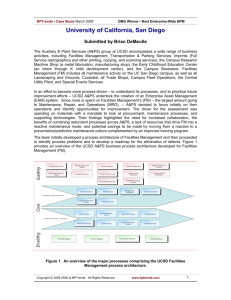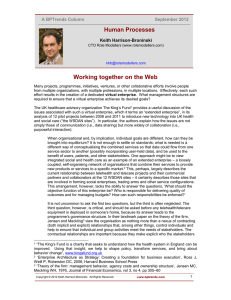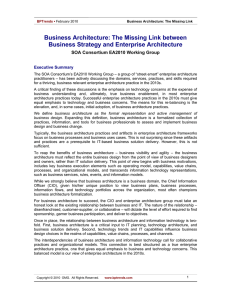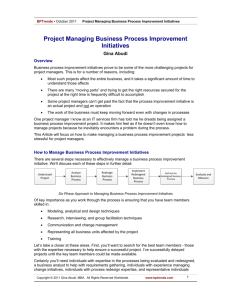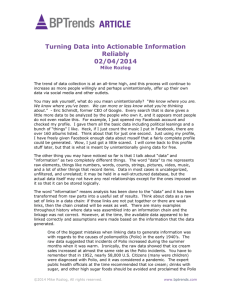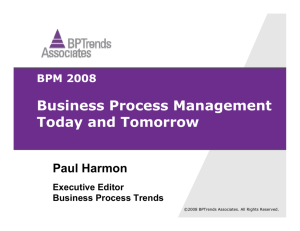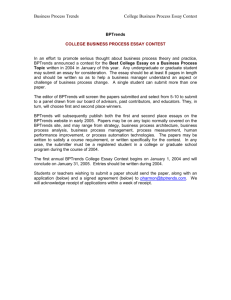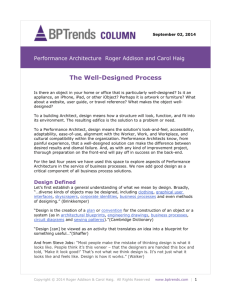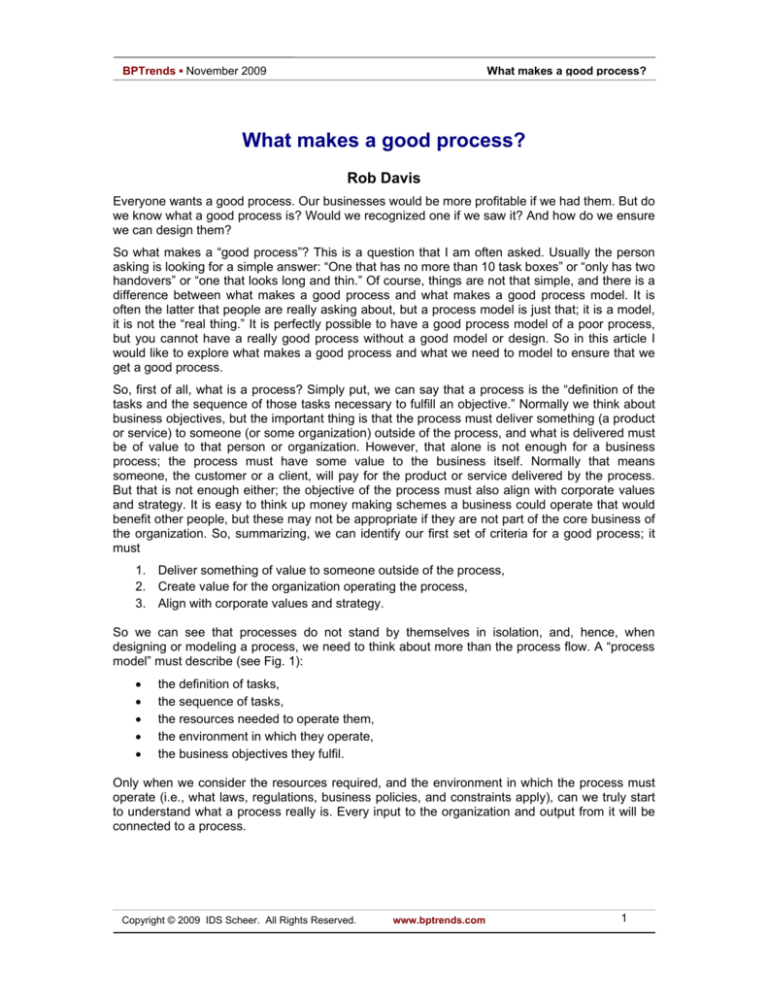
BPTrends ▪ November 2009
What makes a good process?
What makes a good process?
Rob Davis
Everyone wants a good process. Our businesses would be more profitable if we had them. But do
we know what a good process is? Would we recognized one if we saw it? And how do we ensure
we can design them?
So what makes a “good process”? This is a question that I am often asked. Usually the person
asking is looking for a simple answer: “One that has no more than 10 task boxes” or “only has two
handovers” or “one that looks long and thin.” Of course, things are not that simple, and there is a
difference between what makes a good process and what makes a good process model. It is
often the latter that people are really asking about, but a process model is just that; it is a model,
it is not the “real thing.” It is perfectly possible to have a good process model of a poor process,
but you cannot have a really good process without a good model or design. So in this article I
would like to explore what makes a good process and what we need to model to ensure that we
get a good process.
So, first of all, what is a process? Simply put, we can say that a process is the “definition of the
tasks and the sequence of those tasks necessary to fulfill an objective.” Normally we think about
business objectives, but the important thing is that the process must deliver something (a product
or service) to someone (or some organization) outside of the process, and what is delivered must
be of value to that person or organization. However, that alone is not enough for a business
process; the process must have some value to the business itself. Normally that means
someone, the customer or a client, will pay for the product or service delivered by the process.
But that is not enough either; the objective of the process must also align with corporate values
and strategy. It is easy to think up money making schemes a business could operate that would
benefit other people, but these may not be appropriate if they are not part of the core business of
the organization. So, summarizing, we can identify our first set of criteria for a good process; it
must
1. Deliver something of value to someone outside of the process,
2. Create value for the organization operating the process,
3. Align with corporate values and strategy.
So we can see that processes do not stand by themselves in isolation, and, hence, when
designing or modeling a process, we need to think about more than the process flow. A “process
model” must describe (see Fig. 1):
•
•
•
•
•
the definition of tasks,
the sequence of tasks,
the resources needed to operate them,
the environment in which they operate,
the business objectives they fulfil.
Only when we consider the resources required, and the environment in which the process must
operate (i.e., what laws, regulations, business policies, and constraints apply), can we truly start
to understand what a process really is. Every input to the organization and output from it will be
connected to a process.
Copyright © 2009 IDS Scheer. All Rights Reserved.
www.bptrends.com
1
BPTrends ▪ November 2009
What makes a good process?
Figure 1.
Key Aspects of a Process Model
Having defined the basic context and characteristics of a process, we can start to think some
more about what would make such a process a “good process.” A good process is one that is
•
•
•
•
•
•
•
•
•
Effective
Efficient
Relevant
Valid
Usable
Used
Reused
Managed
Measured
Effective
First, and most important. the process must do what it is supposed to; it must be simple and
make life better for all concerned. It must demonstrably deliver value to the customers. It must
satisfy and delight them. In satisfying them, it must meet their needs and fulfill the contract or
agreement that has been made with them. So it must deliver what was agreed, on time and for
the price that was agreed. The product or service must work, and it must continue to work for a
reasonable period of time. This applies whether the process is delivering to an external customer
or to other departments or users in the same organization. Often these customer requirements
are called the “Voice of the Customer,” which may also include service level guarantees imposed
by a regulator on behalf of the customer.
Being “customer focused” or taking what is often called an “outside in” approach, is a major goal
of process effectiveness, but it is not the only goal. The process must also align with the ‘Voice of
the Business,” which defines the business’ strategy, values, and policies. We can’t just respond to
everything the customer wants as this may be too costly or not part of the business strategy.
Copyright © 2009 IDS Scheer. All Rights Reserved.
www.bptrends.com
2
BPTrends ▪ November 2009
What makes a good process?
Efficient
The “Voice of the Business” is also concerned with the efficiency of the process and will impose
constraints that ensure the business is profitable or ensures that a not-for-profit organization
operates within its budget. The process must be devoid of waste, unnecessary steps, multiple
hand-overs and other wasteful characteristics. The process must use available resources to best
effect and, ideally, as I will mention later, reuse common processes and IT services.
So the design and operation of a “good process” must serve two masters – the “Voice of the
Customer” and the “Voice of the Business.” The way in which it does that or, rather, the
measurement of how effectively it does it, is often called the “Voice of the Process” (see Fig. 2).
Figure 2. Process Drivers and Measures
Relevant
The process must, of course, be relevant to the business, but what does that mean? Aren’t all
the processes relevant? Well, of course, they are, but inevitably some are more important than
others, and some are more appropriate to focus on than others. Essentially, we use processes
because “we don’t want to leave the operation of our business to chance.” For most businesses,
it is important that the main activities are consistent, repeatable, and of a high quality. We want
our customers to have a good experience and essentially the same experience each time they
contact us.
In the first instance, we want to concentrate on those processes that deliver and maintain the
service to the customer and the cash flow to the business. It is important to look at the whole
rather than the part and not to dwell on isolated subprocesses, but to look along the length of the
“end-to-end” process that takes a customer order at the start, delivers the product, and receives
payment at the end. So this “order-to-cash” process is one of the relevant or core business
processes that flow through the different business functions or departments (see Fig. 3). It is vital
to think through the process end-to-end. A process that delivers an excellent product to the
customer is of no use if it doesn’t also describe how they should pay for it!
A way to understand the structure of the business processes, and that will add value, is to
construct a process architecture or process landscape. A “good process” is one that fits into the
corporate process architecture.
Copyright © 2009 IDS Scheer. All Rights Reserved.
www.bptrends.com
3
BPTrends ▪ November 2009
Figure 3.
What makes a good process?
Value-driven End-to-End Processes
Other E2E processes include “fault-to-repair” and “concept to market.” Often business do not get
around to thinking about “concept to market” – the new product introduction process – as it is not
seen as an important operational process. It is often thought of as a supporting process or maybe
not even a process at all, but a project. However, it is the C2M process that ensures that new
products and services meet customer needs and corporate strategy and that effective and
efficient “order-to-cash” and “fault-to-repair” processes are in place to support them. It also
ensures that processes and IT components are reused to make best use of the corporate
infrastructure. So maybe we should think about concentrating on designing C2M first so it can
build the infrastructure and ensure “good” operational processes are put in place. I will talk about
this more in a future article.
Valid
A good process must be valid; that is to say, it should be sufficiently correct to be valuable and
usable. That means we must verify and validate it against the customer and business
requirements. You might be surprised that I have said “sufficiently correct.” Shouldn’t processes
be completely correct? Well, the thing to keep in mind is that a process design (and a process
model) is only a representation of the real thing. It can never represent absolutely every aspect of
the real world so it must be “correct enough” for the purpose for which it will be used. If it is going
to be used to develop a completed automated IT driven process, then the model must be tested
against all likely scenarios to ensure that it will be robust in all eventualities. If, on the other hand,
it is going to be used as a training aid for managers, it might only be necessary to cover a few key
scenarios at a high level of abstraction. Even with an automated process it is not possible to
cover every possible scenario, and a fault handling route is needed where a person can resolve
the problems and issues that occur less frequently.
When the process design or model is complete, it must be tested. There are two main stages to
testing: verification and validation. Verification is about ensuring that the design meets the
specification or requirements. Validation is about making sure the process is fit for purpose. Well,
aren’t these the same thing? They would be if we could be sure than the requirements were
correct and complete or that the world had not moved on since they were defined. In practice,
there will often be a difference between what was required and what is now actually needed. A
Copyright © 2009 IDS Scheer. All Rights Reserved.
www.bptrends.com
4
BPTrends ▪ November 2009
What makes a good process?
good process is one where it has been verified that it meets the requirements, but that it has also
been validated against true business needs. One increasingly popular approach to ensuring a
close fit to customer needs is to use agile techniques that focus on iteratively developing
solutions in collaboration with the customer. Agile techniques are becoming widely used in
software development, and we may see them increasingly employed to deliver good processes.
We also need to think about what the process is actually processing. In the manufacturing
industry it will be processing raw materials and turning them into finished products. However, in
the service industry the processes are dealing with more abstract things (customer orders,
insurance policies, broadband configuration, etc.), and what is normally processed is data. Input
from the customer is recorded as “base data” that is processed and turned into “derived data” that
results in the customer receiving a product or service (see Fig.1). The conclusion of this is that we
can’t be sure our process is correct unless we model the data that flows through it and ensure
that it is complete and consistent.
Usable
The process, and particularly the process model, should be realistic and usable. That is to say, it
should capture business elements that really are processes; i.e., business aspects that are
repeatable and predictable. It should contain the right amount of information to make it valuable.
A process model is a “model” in the true sense of the word. Just like the model of a building or an
aircraft, it is built to a certain scale. and it has a certain level of detail. Normally it will have been
built for a particular purpose and will have a particular audience and viewpoint. A process model
is the same; it will have been created for a purpose – for instance, for training process operators
or for providing the specification for IT system development. The amount and type of detail that
needs to be modeled will depend on the use to which it is put, and, hence, the model may not be
of much use for a different purpose. This is why it is so important to understand what the model
will be used for before you start modeling. So a good process, and a good process model, is one
that has clear objectives.
The process must be as simple as it can be while still meeting customer and business needs. Of
course, these can be two conflicting objectives, and “real” processes are often criticized because
they are too complex. However, businesses are complex, and so are many processes, so we
must do our best to make them easy to understand by the different people who have to use them.
This may mean presenting process information in different ways to different types of people, and,
of course, the process must have been made visible in the first place via a process portal. A
“good process” is one that is visible, simple, and understandable.
Many people fall into the trap of only modeling the “sunny day” scenario or the “happy path.” That
is to say, they only model what happens when things go right. However, a customer’s opinion of
an organization is often made or broken by the experience they receive when things go wrong. A
problem handled efficiently and resolved quickly can often boost a customer’s opinion of an
organization, while you can be sure the customer will tell all their friends about a problem handled
badly. Judging the amount of detail and the number of failure scenarios to handle is a difficult call,
but keep in mind, does it
•
•
•
•
•
affect the customer?
affect revenue or profit?
affect key process metrics (KPIs)?
have regulatory impact?
consume significant resources?
Generally, the process must also be maintainable and maintained. It is rare that a process will be
designed and left completely unchanged throughout its life. However, as good as process is, it
can always be improved, and, in any case, the world does not stay still. Customers’ needs
change, the economic environment changes, the business evolves, and new technology
becomes available. All of these factors mean that the process requires continuous review and
change. However, in many organizations, much effort is expended in documenting a process only
to then file away the design and never touch it again. Often the reason for this is that processes
Copyright © 2009 IDS Scheer. All Rights Reserved.
www.bptrends.com
5
BPTrends ▪ November 2009
What makes a good process?
have been laboriously documented using Microsoft PowerPoint or Visio and are then very difficult
to change. Designing the process in a modeling tool, on the other hand, provides a much more
efficient environment for analysis, change, and communication. So a good process design is one
that has been produced in a way that it can be easily maintained.
We must also keep in mind that most processes require a significant amount of activity to be
done by people. We must make sure that we design the process to make best use of people’s
skills, to allow them to do the things they do best, and to remove repetitive and tedious activities
that encourage errors and poor service. A “good process” is one that uses people effectively.
Used
It is no good putting all this effort into creating an effective and efficient process, making it usable
and visible, if no one actually uses it. Making sure that your process design makes a difference is
one of the key challenges for creating good processes. Because processes are mainly about
what people do (despite all the IT automation), implementing a new process is essentially a
“change management” activity. All of the normal change management activities – getting buy-in,
training, barrier removal, reward, and monitoring – are essential for getting processes used. Just
as with the process owner, having the right reward structure in place is essential for encouraging
the desired behavior.
Of course, one way to ensure your process is actually used is to fully automate it, and we could
spend a long time discussing process-driven IT, ERP, SOA, and many of the other IT issues.
However, I will leave that for others to pursue.
Reused
Reuse is a key enabler for improving business efficiency. It is widely employed for IT systems and
software development, and there is a huge desire to employ similar techniques for processes. We
can employ reuse in many ways. Employing best practice is one form of reuse; process
standardization is another; reusing process components or business services is another. A good
process is one that does not reinvent everything from scratch, but reuses many process and IT
components. However, reuse is not easy. How do you define what can be reused? How do you
describe it? How do you develop a process for reuse and who pays? I will look at process reuse
in more detail in a future article.
Managed
A good process must be managed and improved. We can’t just design a process and leave it to
its own devices. A process must have an owner who is responsible for directing its design,
ensuring it aligns with requirements and business strategy. The owner will ensure that measures
and KPIs are in place and will most likely have their own performance scorecard based on the
process measures. The owner oversees the day-to-day operation of the process, which may be
managed by a number of different subprocess managers. The process owner is responsible for
coordinating the local management of process components to ensure that end-to-end process
performance is maintained. The owner doesn’t just ensure that the process keeps operating but
leads process improvement initiatives to improve efficiency and effectiveness and ensure the
process maintains alignment with business strategy, customer demands, and changing
infrastructure. To make this effective, the reward structure for the process owner should be built
around the performance of their process. Process ownership and management are fundamental
cornerstones of Business Process Management.
Measured
A good process must be measurable and actually measured. Well, you might think that any
process can be measured, but in practice few processes have credible measures identified, and
even fewer have IT systems in place to make those measures. Processes are not just something
your business does – for instance, like creating the company accounts or running the pension
scheme; processes “are” the business. Processes are the very lifeblood that makes the business
operate so it’s not really possible to understand how well your business is performing unless you
understand how well your processes are performing. Of course, you may argue that businesses
Copyright © 2009 IDS Scheer. All Rights Reserved.
www.bptrends.com
6
BPTrends ▪ November 2009
What makes a good process?
have been doing just that for a long time, but times have changed. The customer has more
choice than ever, market conditions change rapidly, and current business measures (annual
profit, share price, revenue growth, and customer satisfaction) are lagging measures that take
time to show the real trend. Often, by the time these measures indicate a problem, it is too late to
do anything about it. Process measures, on the other hand, provide leading measures of how the
business is operating now, how the business strategy is realized, and, more importantly, measure
how individual customer interactions are performing (see Fig. 4). A process can’t be judged to be
a “good process” if it is not measured, because if we are not measuring it how do we know?
Figure 4.
Business Process Measures
So how do we get a good process?
I have set out a lot of criteria for a good process and for creating a good process model, so how
do we go about getting a good process? We need to consider these key principles:
•
•
•
•
•
•
•
•
•
Requirements and Business Strategy
Process Governance
Process Architecture and Structure
Performance Management
Design and Documentation
Implementation and Change Management
IT Alignment
Monitoring
Continuous Improvement
These are, in fact, my nine principles of BPM process excellence (see Fig. 5); “good processes”
are those produced by effectively employing Business Process Management.
Copyright © 2009 IDS Scheer. All Rights Reserved.
www.bptrends.com
7
BPTrends ▪ November 2009
Figure 5.
What makes a good process?
Nine Principles of Business Process Management
In future editions of my column I will look at some of the issues involved in implementing these
principles, including:
•
•
•
•
•
•
•
Process is not just something your business does – processes are your business
Concept-to-Market: if we get this right, the other E2E processes will look after themselves
One size doesn’t fit all: the need for a roadmap for successfully implementing BPM
Reuse is good for you, but do we really understand what we are reusing?
Maturity Models: what are measuring?
The BPM Center of Excellence: rise and fall and rise again
Process patterns: why aren’t we using them?
------Author
Rob is a Senior BPM consultant with IDS Scheer UK (Ltd) and is an internationally recognized
expert in Business Process Management (BPM) and the practical use of the ARIS Design
Platform.
Previously, Rob worked for British Telecom (BT) where he was responsible for selecting and
implementing ARIS in a large scale implementation. Rob has built extensive experience of all
aspects of BPM and specializes in providing consultancy on BPM, process modelling and
design, architecture and frameworks, process governance, and integrating process and IT
design. Rob has written three definitive books on the practical use of ARIS Design Platform for
BPM. For more information see http://www.rob-davis.co.uk.
Copyright © 2009 IDS Scheer. All Rights Reserved.
www.bptrends.com
8

